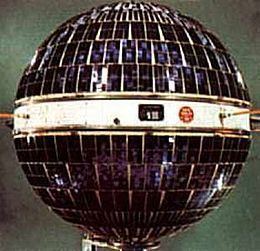Mission type Communication Launch site Cape Canaveral LC-17B Regime Low Earth Inclination 28.33° Period 1.8 hours Rocket Thor-Ablestar | Mission duration 17 days (achieved) Reference system Geocentric Launch date 4 October 1960 Inclination 28.33° Launch mass 230 kg | |
 | ||
Operator United States Air Force Similar ESSA‑1, Space Technology 5, Wide Field Infrared Explorer, Lacrosse, Hitchhiker Program | ||
Courier 1B was the world's first active repeater satellite after launch on 4 October 1960. Courier was built by the Palo Alto, California–based Western Development Labs (WDL) division of Philco, previously known as Army Fort Monmouth Laboratories and now the Space Systems/Loral division of Loral Space & Communications.
Proposed by the U.S. Army Signal Corps in September 1958, Courier was a follow-on to Project SCORE launched in 1958. The first satellite in the series, Courier 1A, was lost in a launch failure 2.5 minutes after liftoff. Courier used approximately 19,000 solar cells and was the first satellite to use nickel–cadmium storage batteries. It had an effective message transmission rate of 55,000 bits per second.
After completing its first orbit, a message from US President Dwight Eisenhower to the United Nations was transmitted from the Deal Test Site, an off-base transmission facility of Fort Monmouth, New Jersey and relayed to a ground station in Puerto Rico.
After 228 orbits in 17 days, the payload failed to respond to commands from the ground. It was believed that the clock-based access codes got out of synchronization and the satellite would not respond to what it interpreted as unauthorized commands.
